
We don't saddle up the horses to ride into town nor do we use candles as our only source of light in our houses. In fact, can you name a technology that you use regularly that has not been improved in the last two hundred years? No, you probably can't. We use modern technology and its conveniences for everything from transportation to communication. So why are we using a technology for running a democracy that is more than two hundred years old, when newer and better technology has been developed?
The latest political theater of the fiscal cliff will soon be followed with a rousing encore by the debt ceiling drama. While there are serious political questions underneath these farcical performances by our elected officials, a much more fundamental question should be triggered in the minds of most Americans: Why are we allowing ourselves to have such a poor democracy? Why do we continue to use antiquated methods of elected representatives? Why do we Americans cling tenaciously to a document drafted centuries ago while the rest of the world has progressed? We Americans soldier on with a set of rules that are ineffective are creating a vibrant democracy yet have succeeded at creating a Congress that cannot even force itself to function, Presidential elections that often don't represent the people's will and a Supreme Court that derives most of its power outside of the Constitution.
As documented in Measure of a Nation, the United States has one of the lowest voter turnout rates of any democratic country. Moreover, in broader measures of democracy like those from the World Bank and the Economist magazine, the United States performs far below that of many other leading democracies. America relies on single-seat, winner-take-all elections which routinely produce uncompetitive elections, incumbent advantage, unrepresentative outcomes, gerrymandered districts and stimulate polarization. Thirty-eight of the 41 democracies with high democracy ratings from Freedom House use some form of proportional or semiproportional representation in at least one of their national legislatures -- America is one of three holdouts. The use of these single-seat, winner-take-all elections is America lighting candles and saddles up its horses of democracy with 18th century democracy technology.
The Constitution was not intended to be a framework for the country for the rest of our nation's history. Jefferson himself expected that every generation should rewrite the Constitution yet America has not taken this approach. While some changes to the Constitution occurred over time, as rights and the definition of who could vote were expanded, the general architecture of the system it laid out has remained relatively unchanged for more than two centuries.
Constitution 1.0, the Articles of Confederation, proved itself to be insufficient to run the new country. Constitution 2.0, our current system, has repeatedly proven itself to be ineffective and suboptimal compared to other democratic systems. It is high time for Constitution 3.0. Any bets on what changes might come out of a 21st century Constitutional Convention?